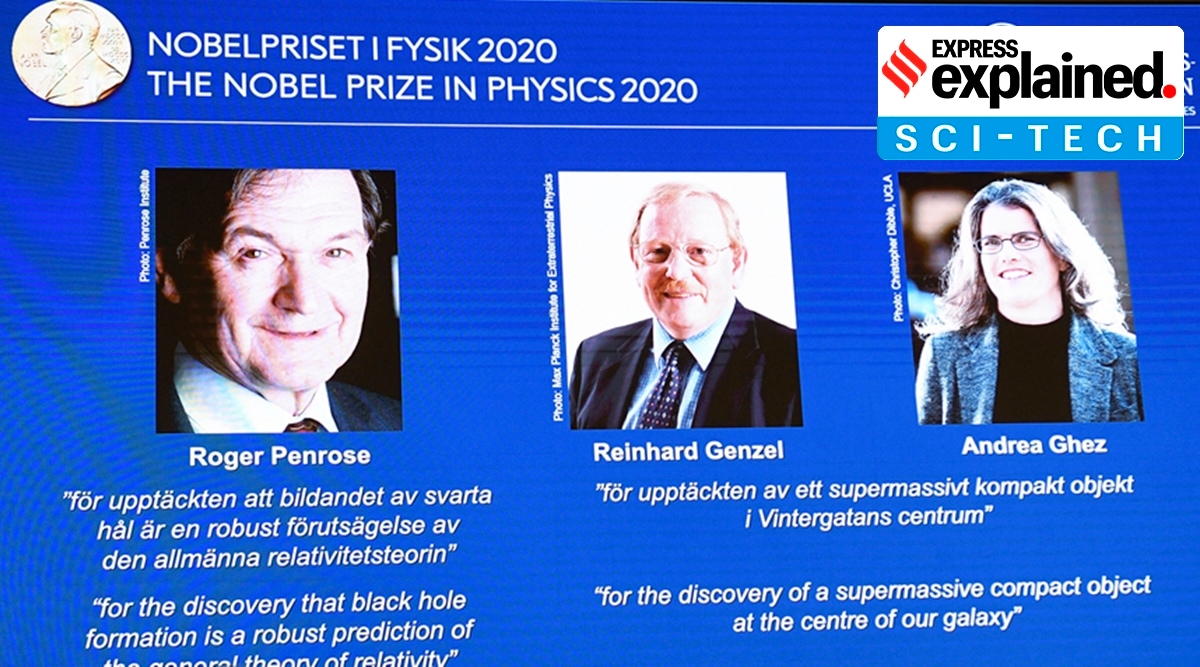Earlier on Monday, three biologists shared the Nobel Prize in medicine for the discovery of the vaccine for the hepatitis C virus.
On Tuesday, the Royal Swedish Academy of Sciences decided to award one half of the 2020 Nobel Prize in physics to Roger Penrose and the other half jointly to Reinhard Genzel and Andrea Ghez for furthering the understanding of black holes, the most “enigmatic” objects in the universe.
Earlier on Monday, three biologists shared the Nobel Prize in medicine for the discovery of the vaccine for the hepatitis C virus.
So what are black holes?
A black hole is formed when stars collapse and can be defined as a space in the universe with an escape velocity so strong that even light cannot escape it.
Escape velocity is the speed at which an object must travel to override a planet or an object’s gravitational force. For instance, for a spacecraft to leave the surface of the Earth, it needs to be travelling at a speed of about 40,000 km per hour.
Since light cannot get out, black holes are invisible and can only be tracked with the help of a space telescope or other special tools. And the reason light cannot escape is mainly that the gravity inside a black hole is very strong as a result of a lot of matter being squeezed into a small space.
So what does the award winners’ work tell us about black holes?
Penrose has been awarded the prize for the discovery “that black hole formation is a robust prediction of the general theory of relativity,” while Genzel and Ghez have been awarded the prize for the discovery of a “supermassive compact object at the centre of our galaxy.”
Penrose’s work has shown that black holes are a direct consequence of Albert Einstein’s general theory of relativity. Einstein himself did not believe that black holes exist and presented his theory in November 1915, providing a new way to look at and understand gravity that shapes the universe “at the largest scale”. Gravity also shapes space and influences the passage of time. It is this gravity, which is so great inside a black hole that is able to bend space and slow down time.
Penrose used Einstein’s general theory of relativity in order to prove that the process of formation of black holes is a stable one. He proved that black holes exist and described them in detail back in 1965, ten years after Einstein died.
Genzel and Ghez, on the other hand, have discovered that an invisible and an extremely heavy object governs the stars’ orbit at the centre of the Milky Way. This extremely heavy object has the mass equivalent to 4 million solar masses and is packed into an area about the size of our solar system.
Essentially, their work tells us that at the centre of our galaxy the Milky Way lies an invisible supermassive object, of which a black hole provides a reasonable explanation. Physicists have been suspecting the existence of a black hole at the centre of our galaxy for over 50 years now.
In order to see through to the middle of the Milky Way, Genzel and Ghez worked on developing methods and used some of the world’s largest telescopes.
By observing the orbits of the stars’ that are closest to the centre of the Milky Way, the physicists think that the black hole could most likely be hiding in Sagitarrius A*, a source of radio waves around which all stars in the Milky Way orbit. In other words, the existence of a black hole at the centre of our galaxy is what the physicists believe is what pulls a “jumble of stars,” causing them to “rush around at dizzying speeds”.
Where does research on black holes go from here?
While work done by Penrose has established that black holes are a “robust” consequence of the theory of relativity and that they are formed naturally in very overdense regions, thereby proving that their formation is a stable process, the theory ceases to apply at the centre of the black hole called the singularity– “a boundary at which all the known laws of nature break down”. This essentially means that the extent to which the theory of general relativity applies to the structure of black holes requires further probing and questions about the internal structure of black holes still remain.
? The Indian Express is now on Telegram. Click here to join our channel (@indianexpress) and stay updated with the latest headlines
For all the latest Explained News, download Indian Express App.
Source: Read Full Article


